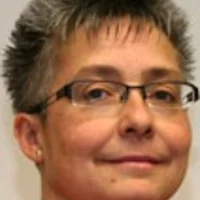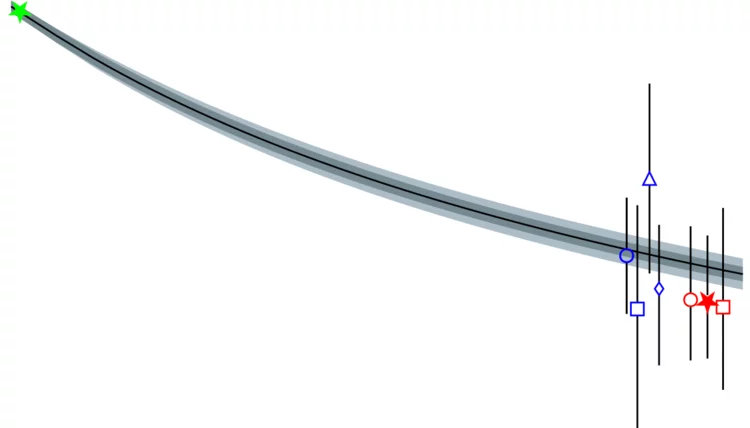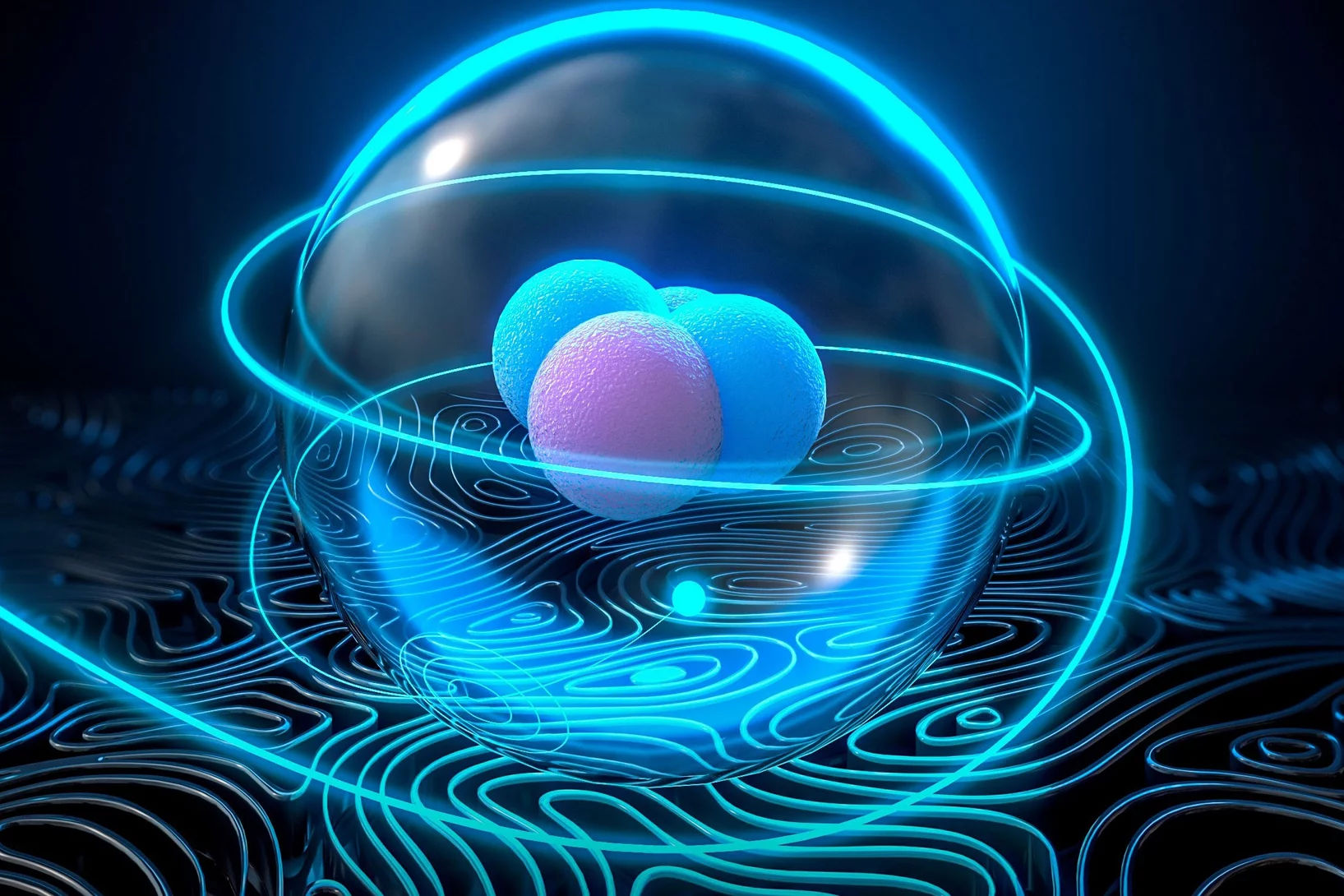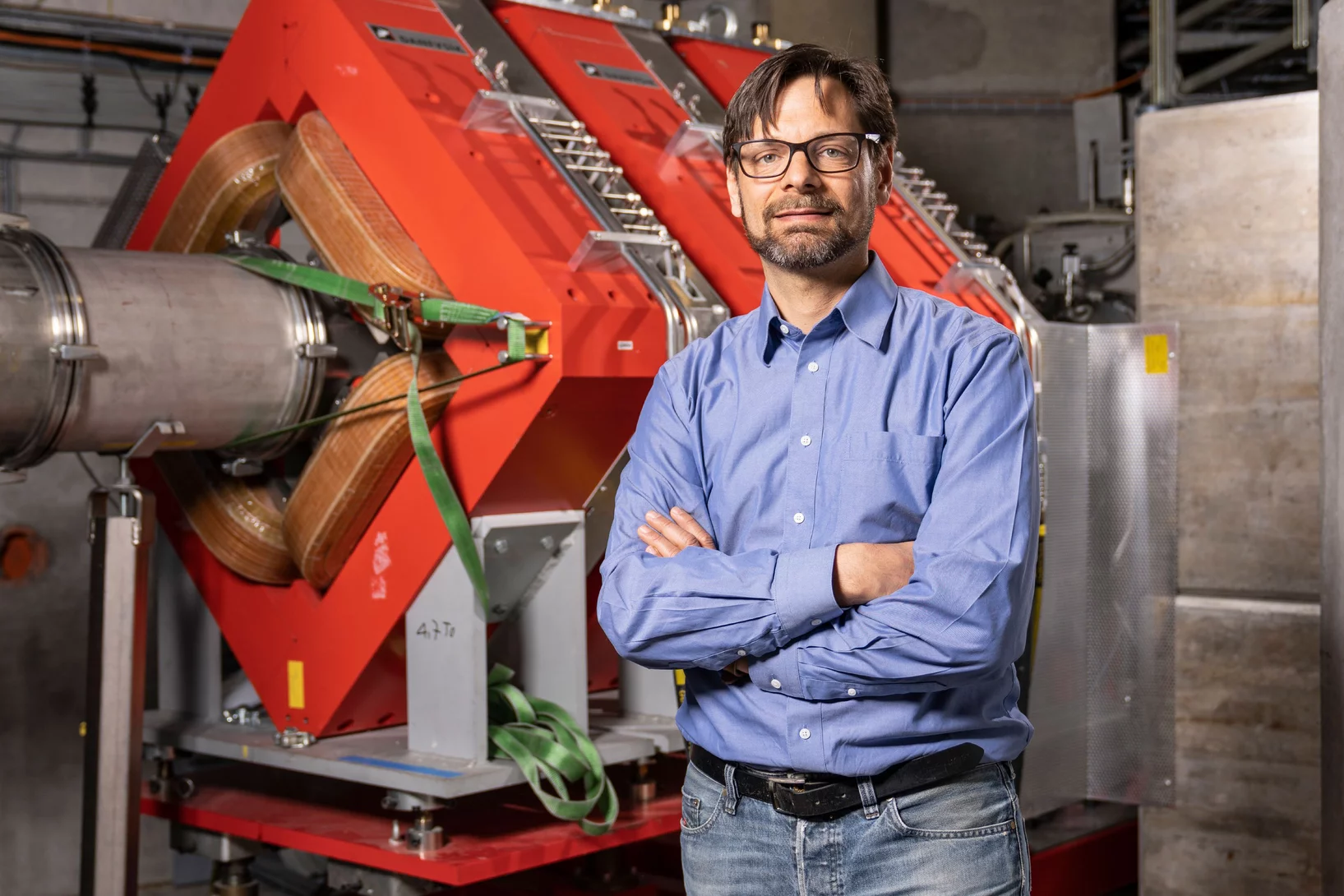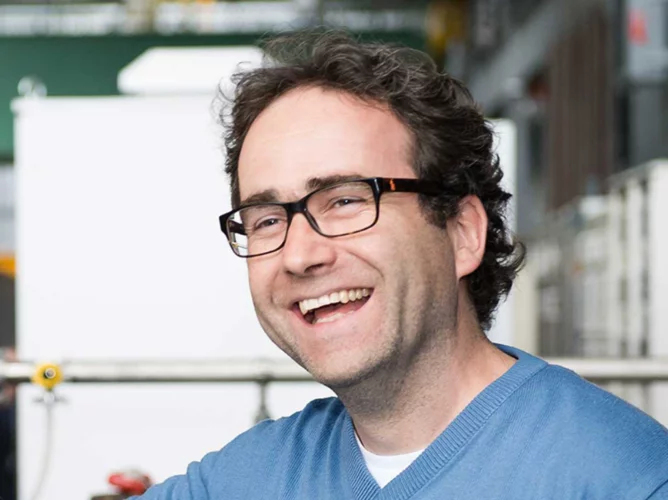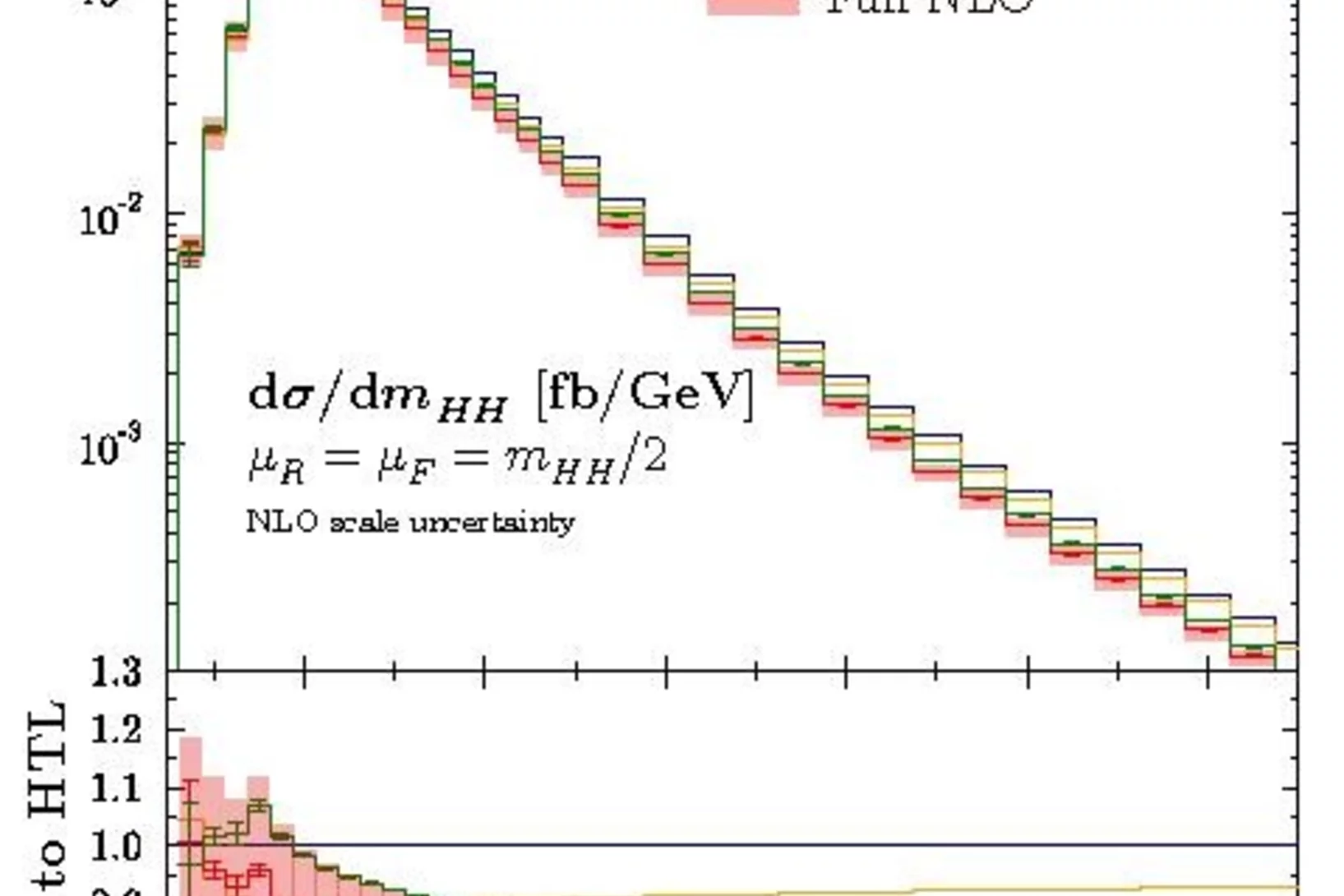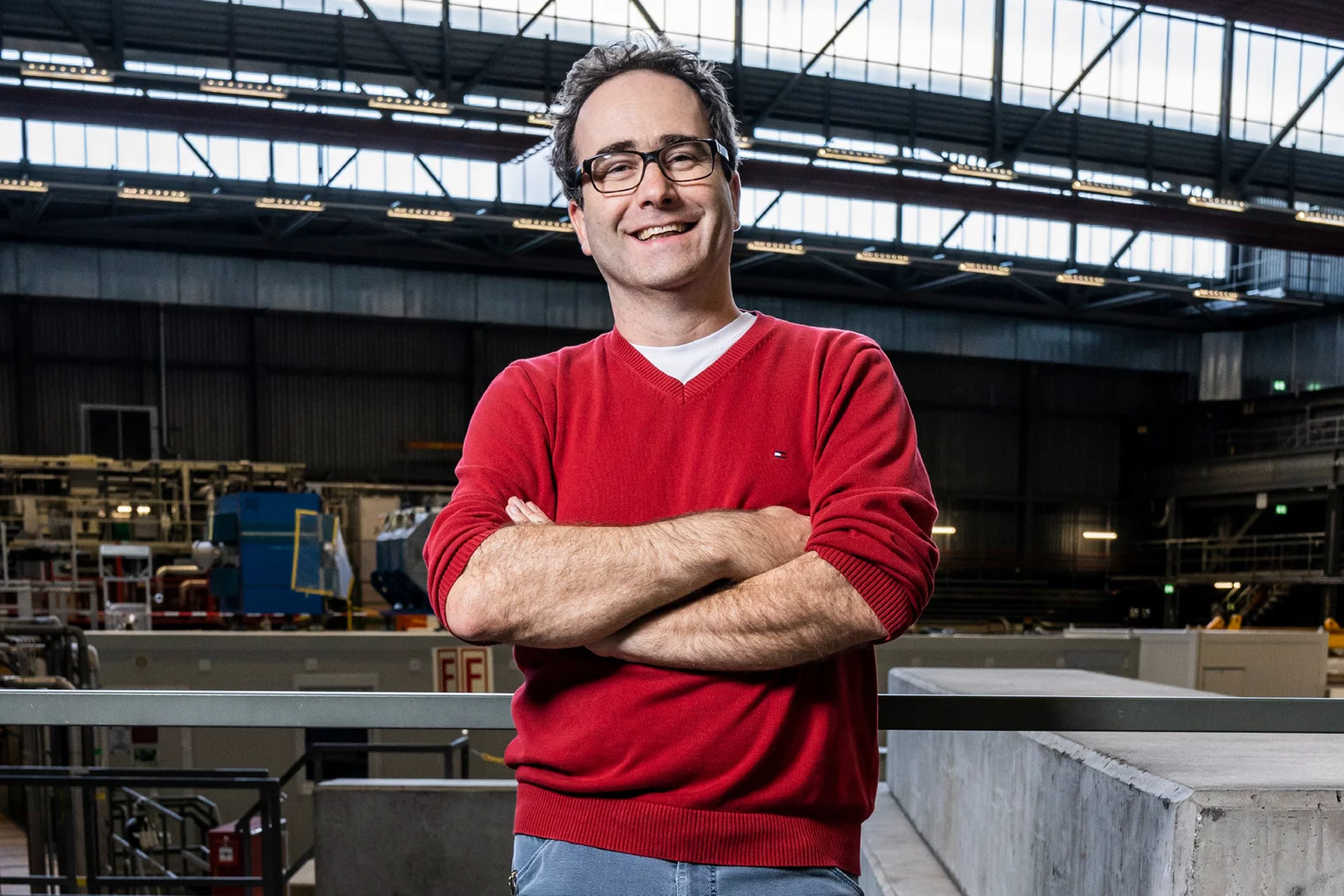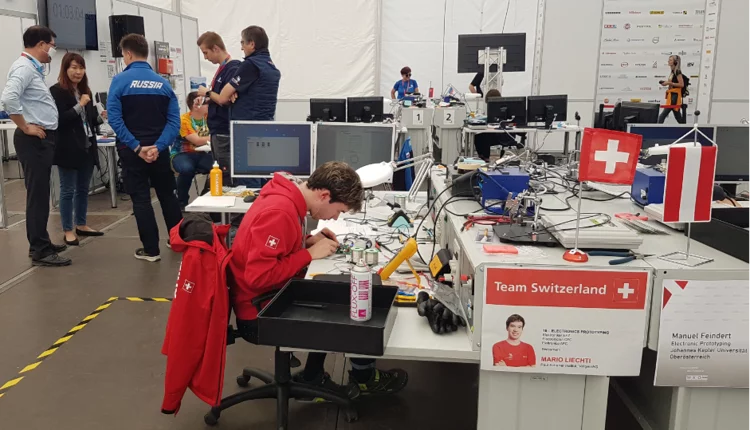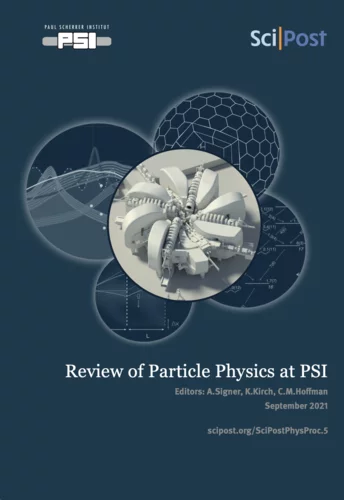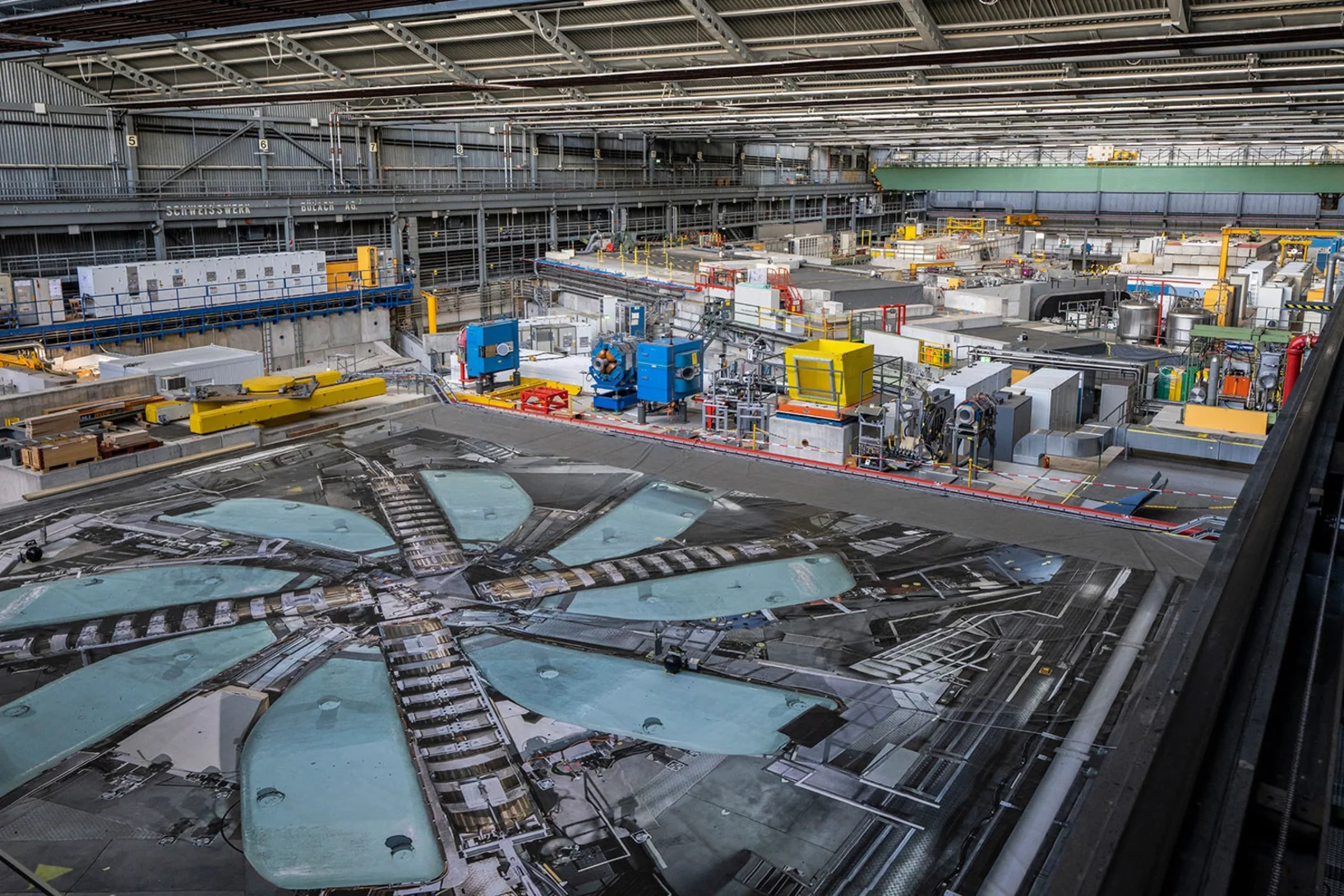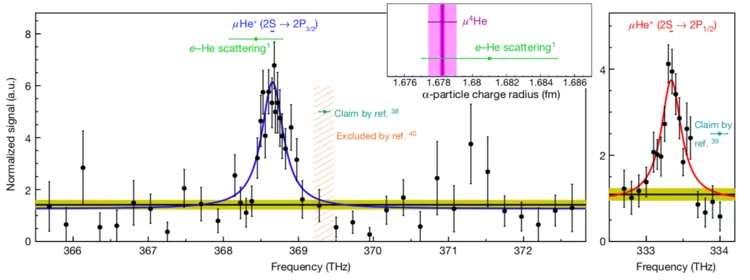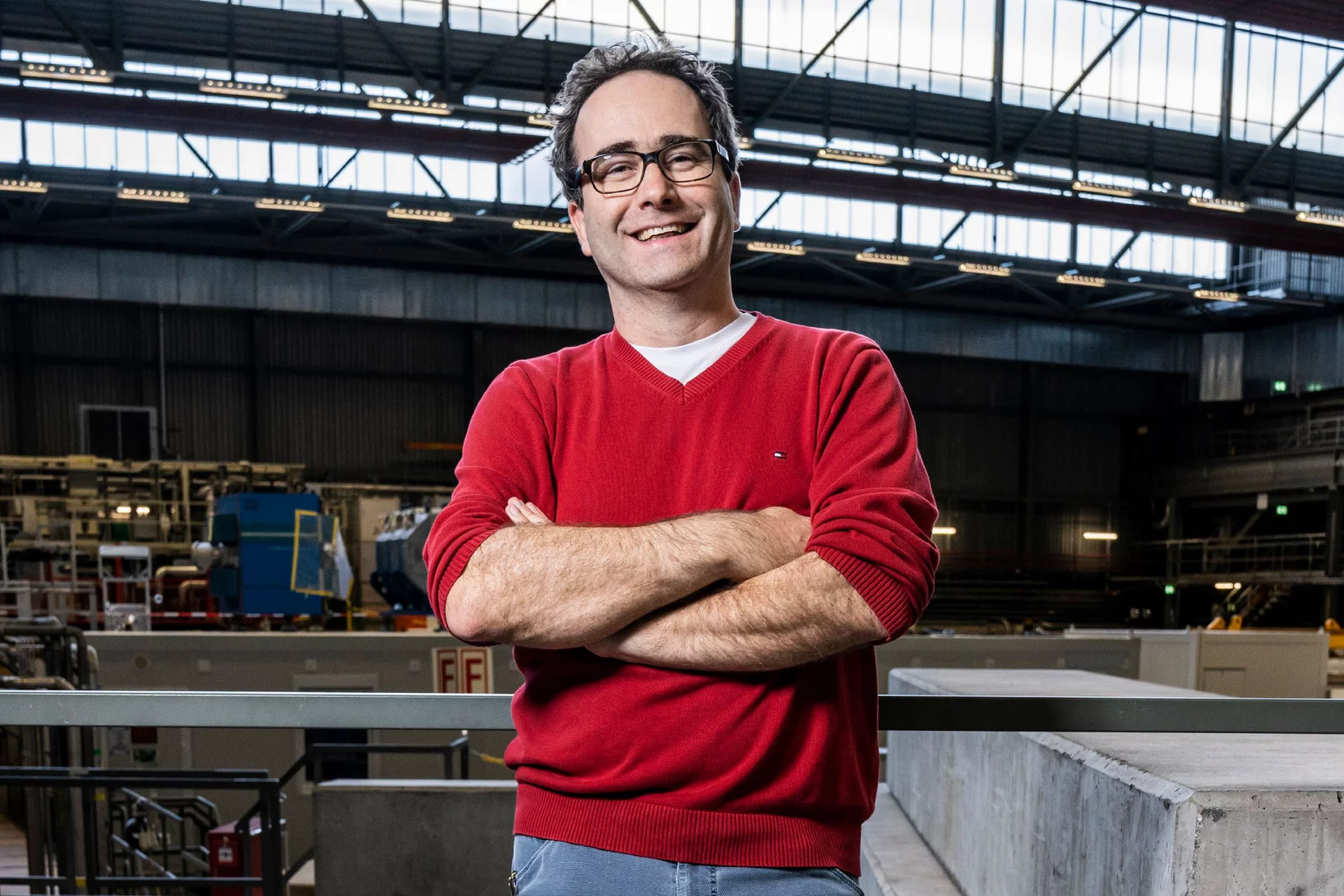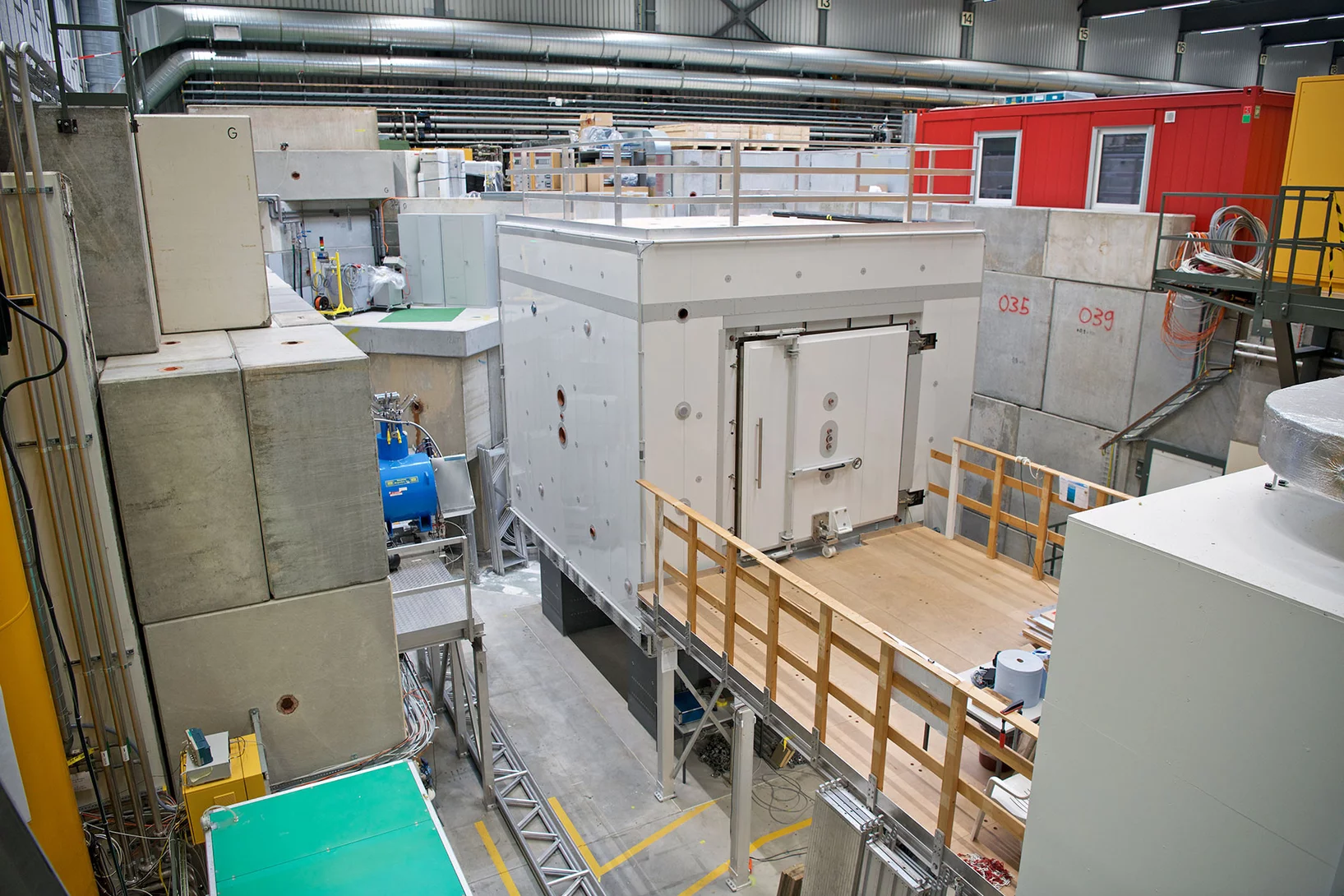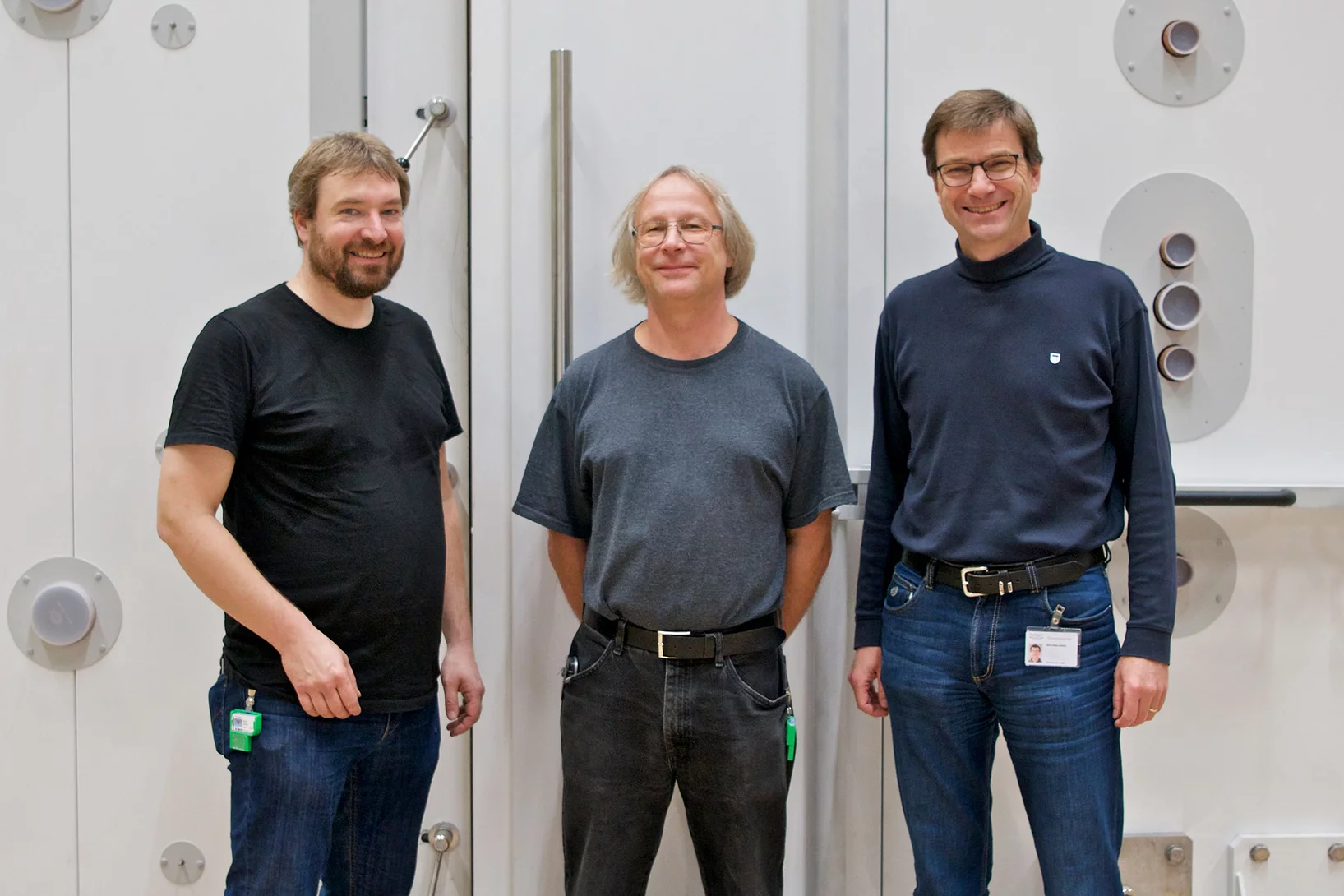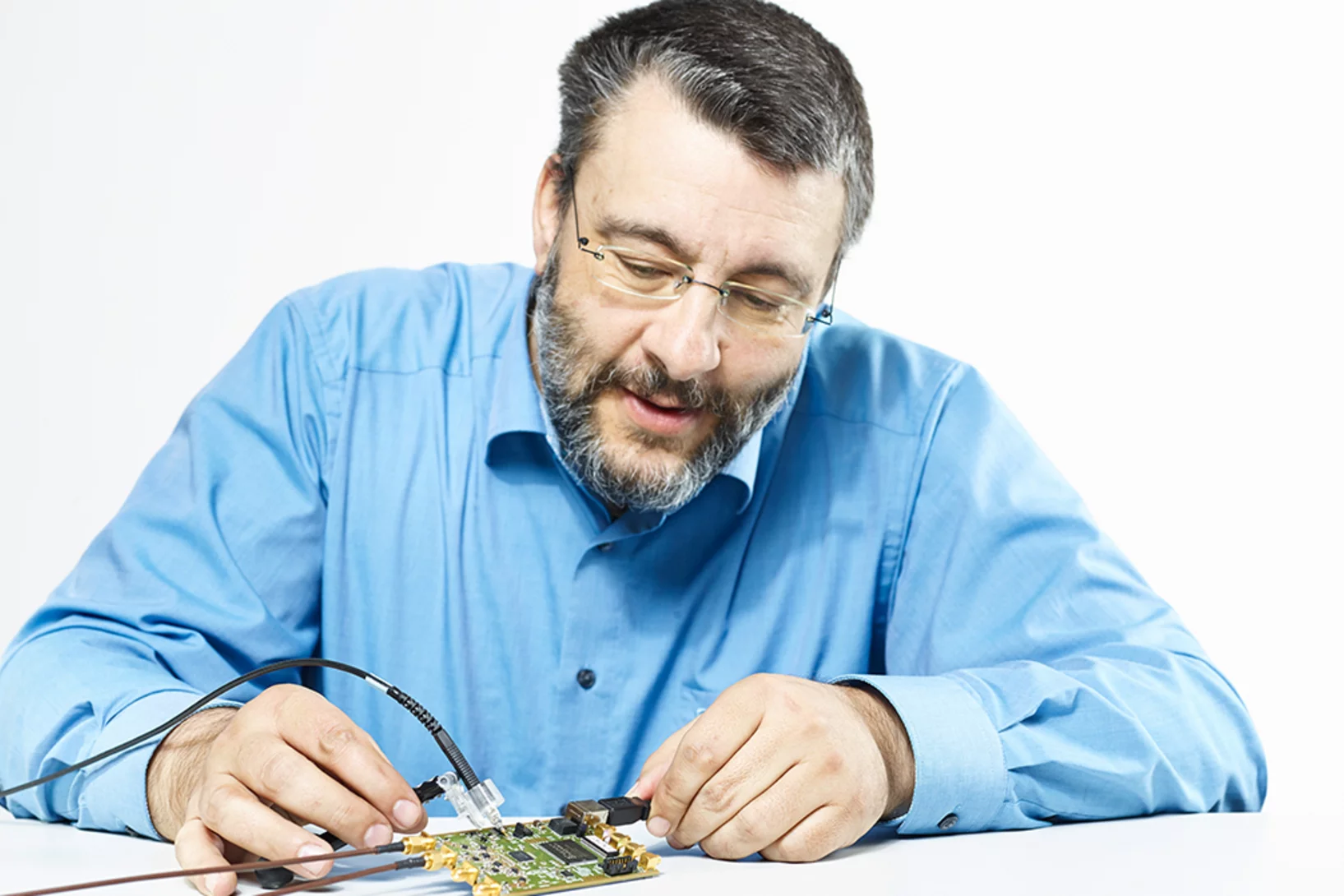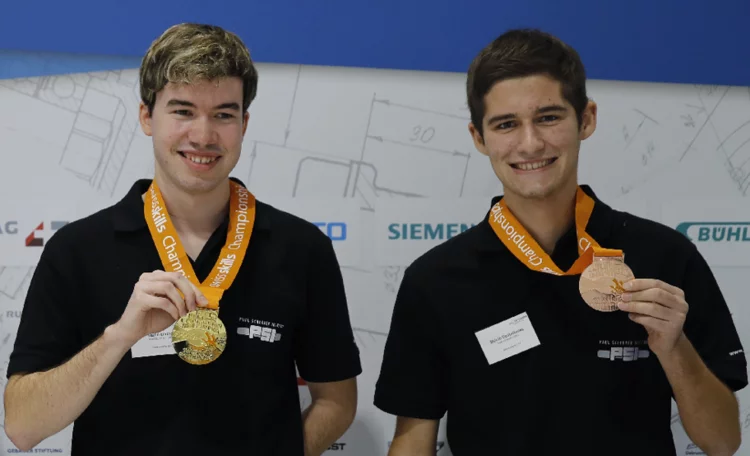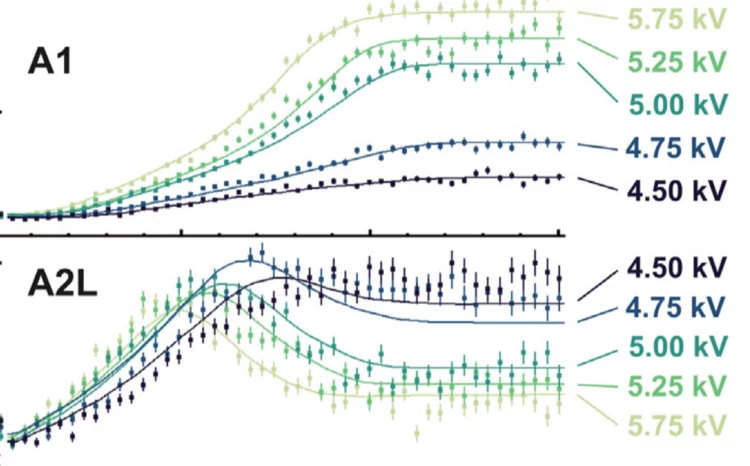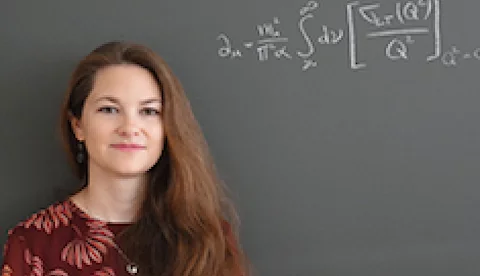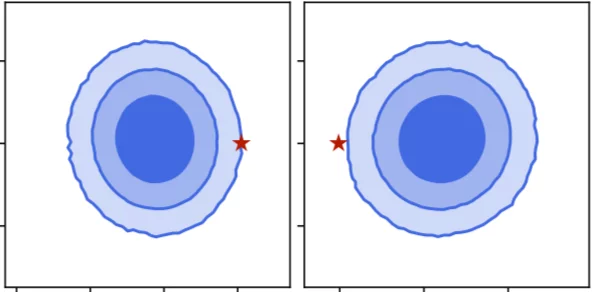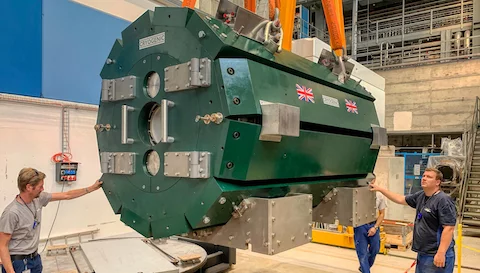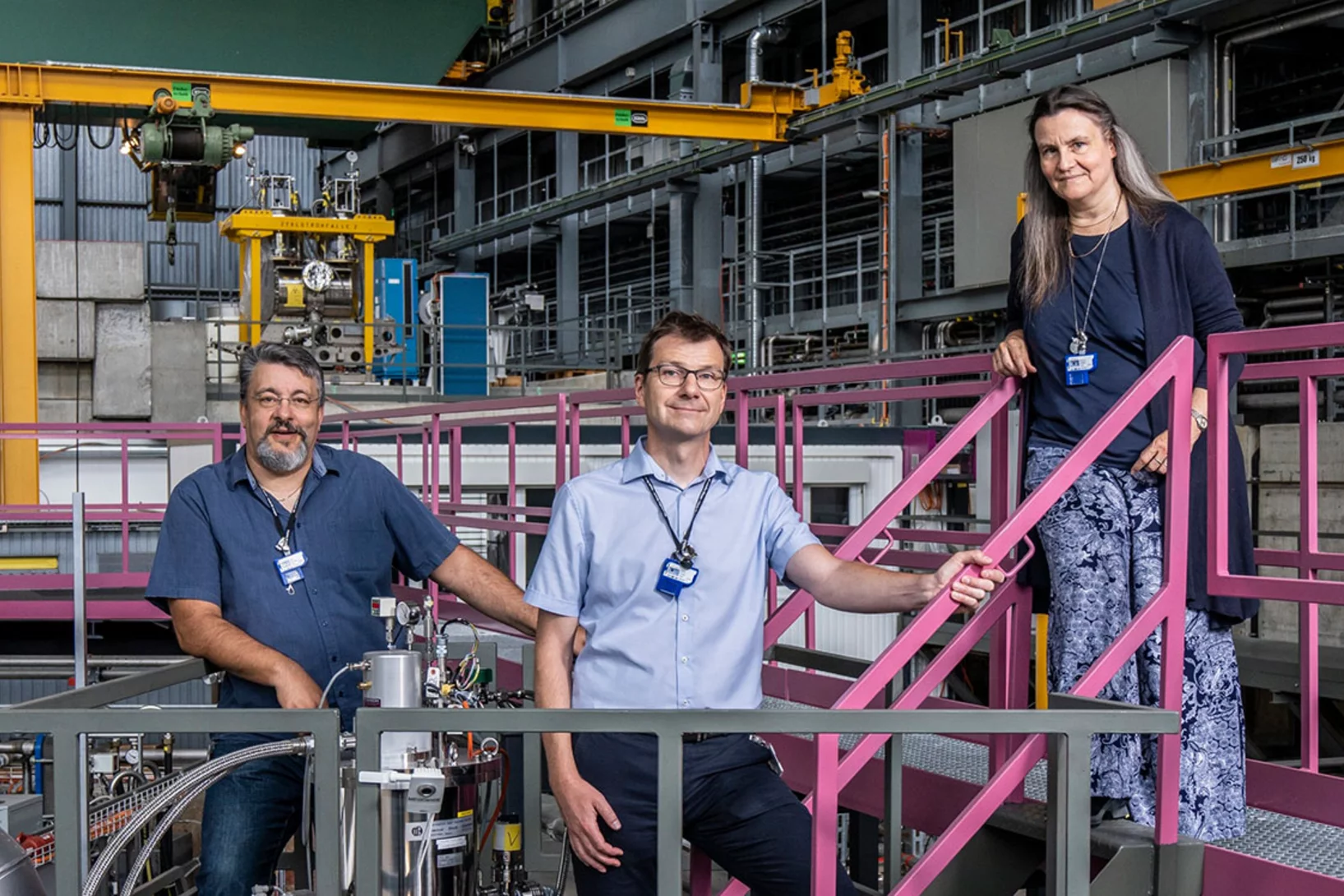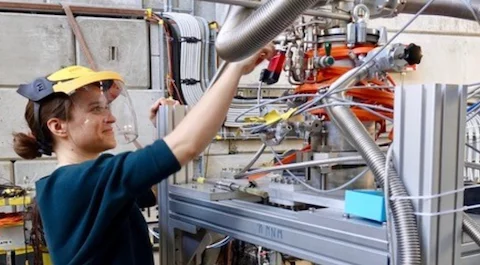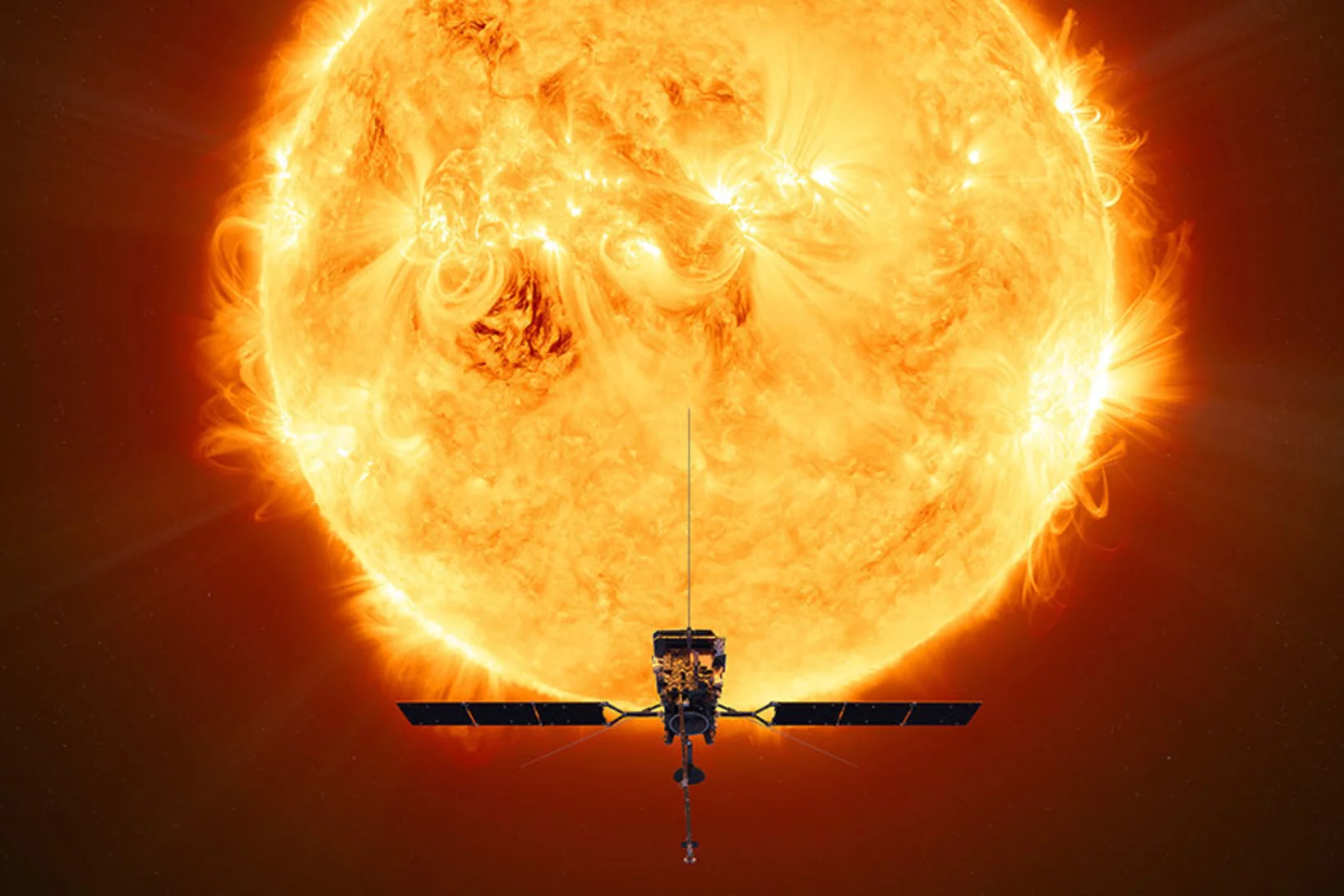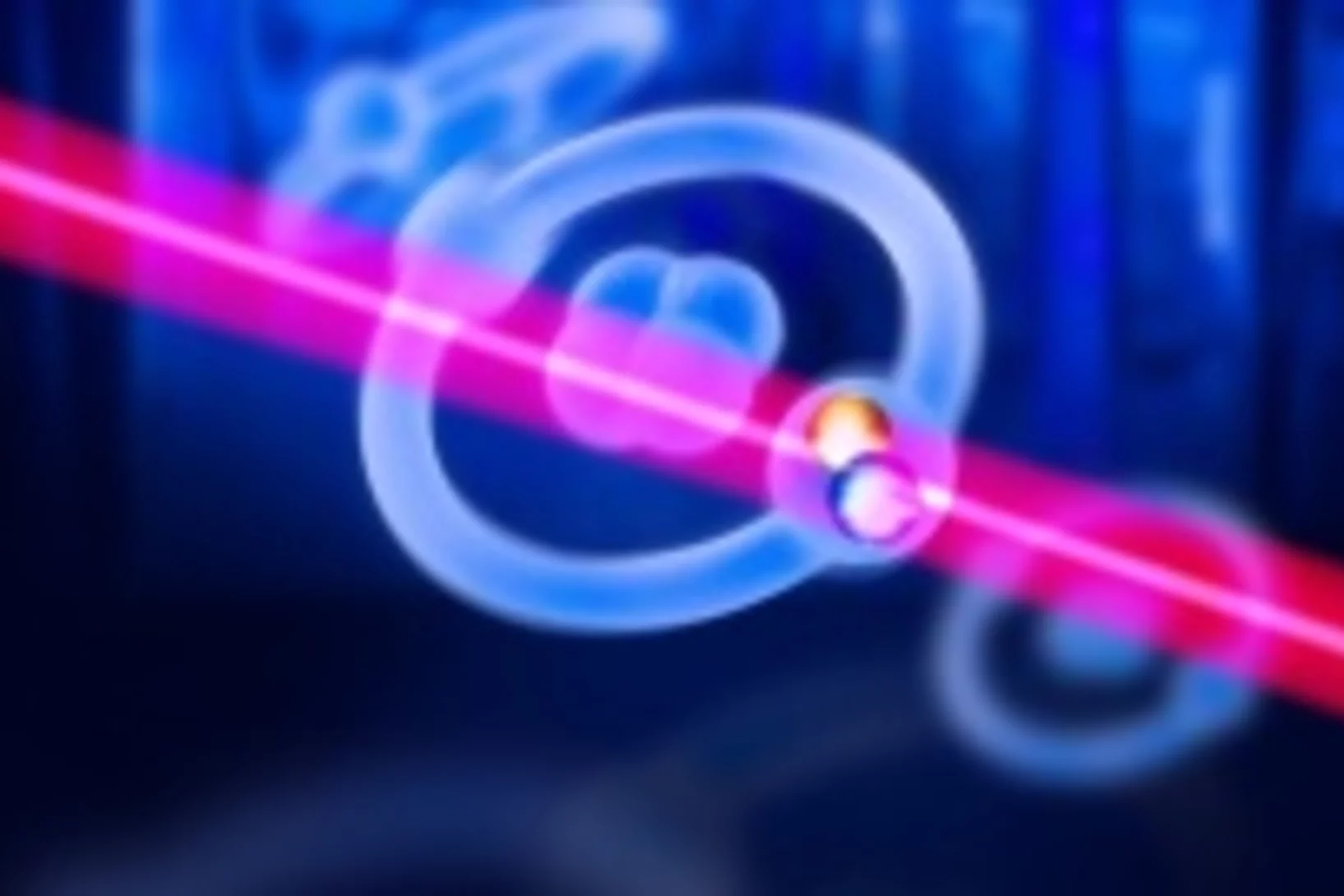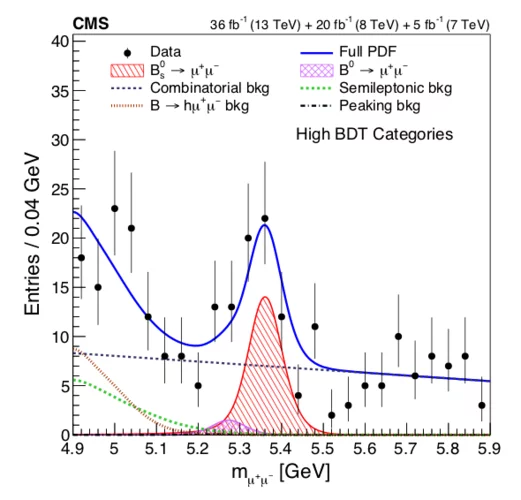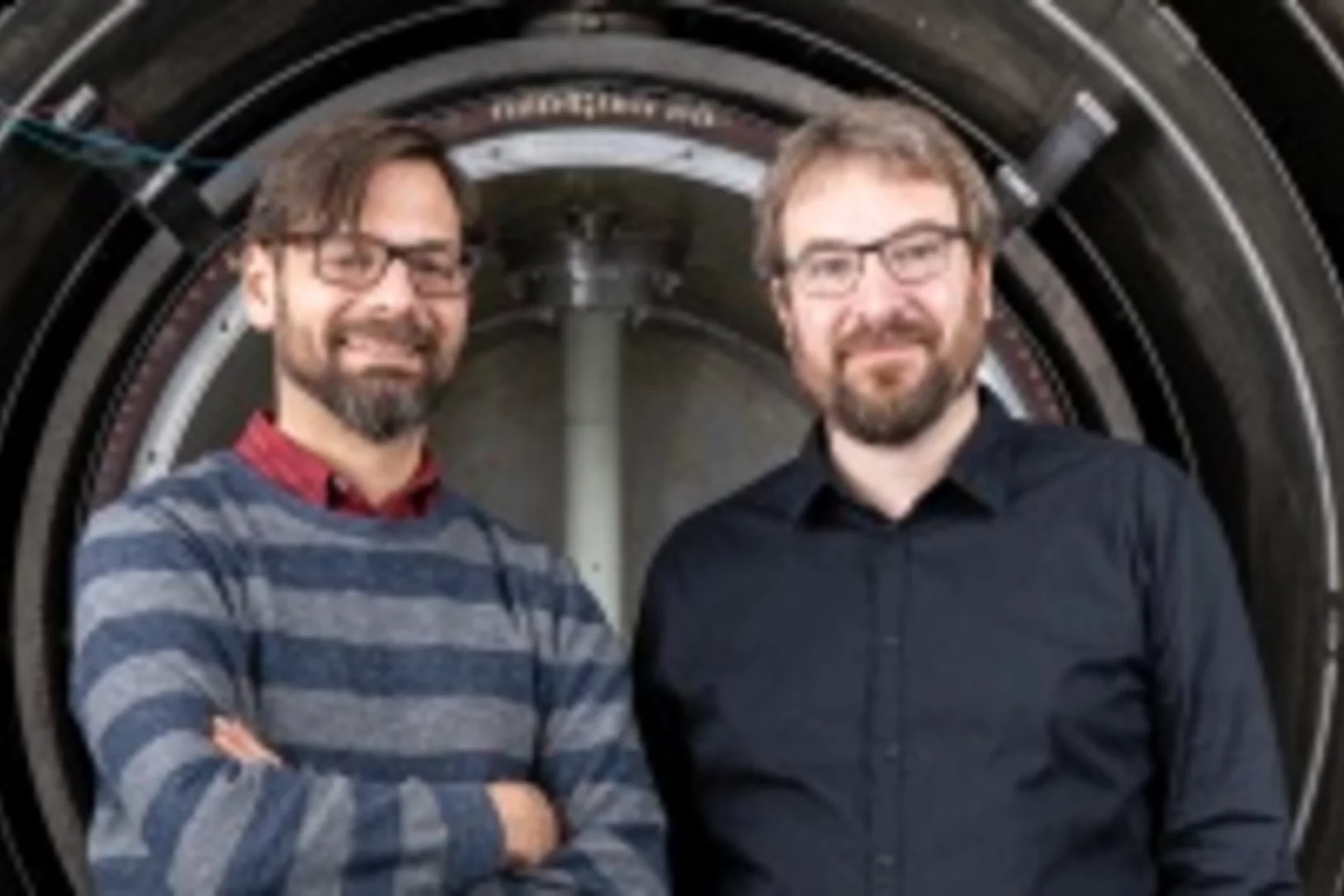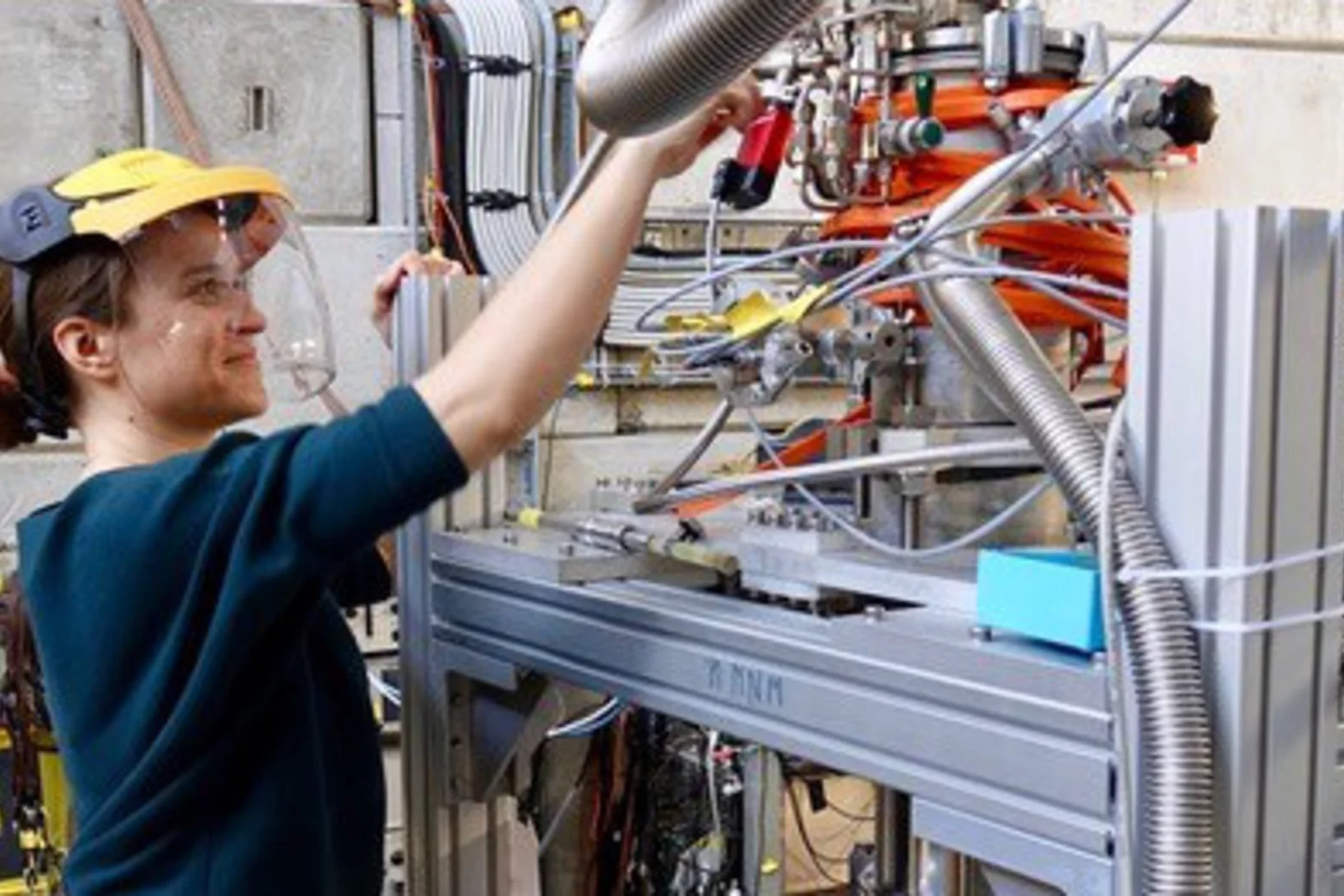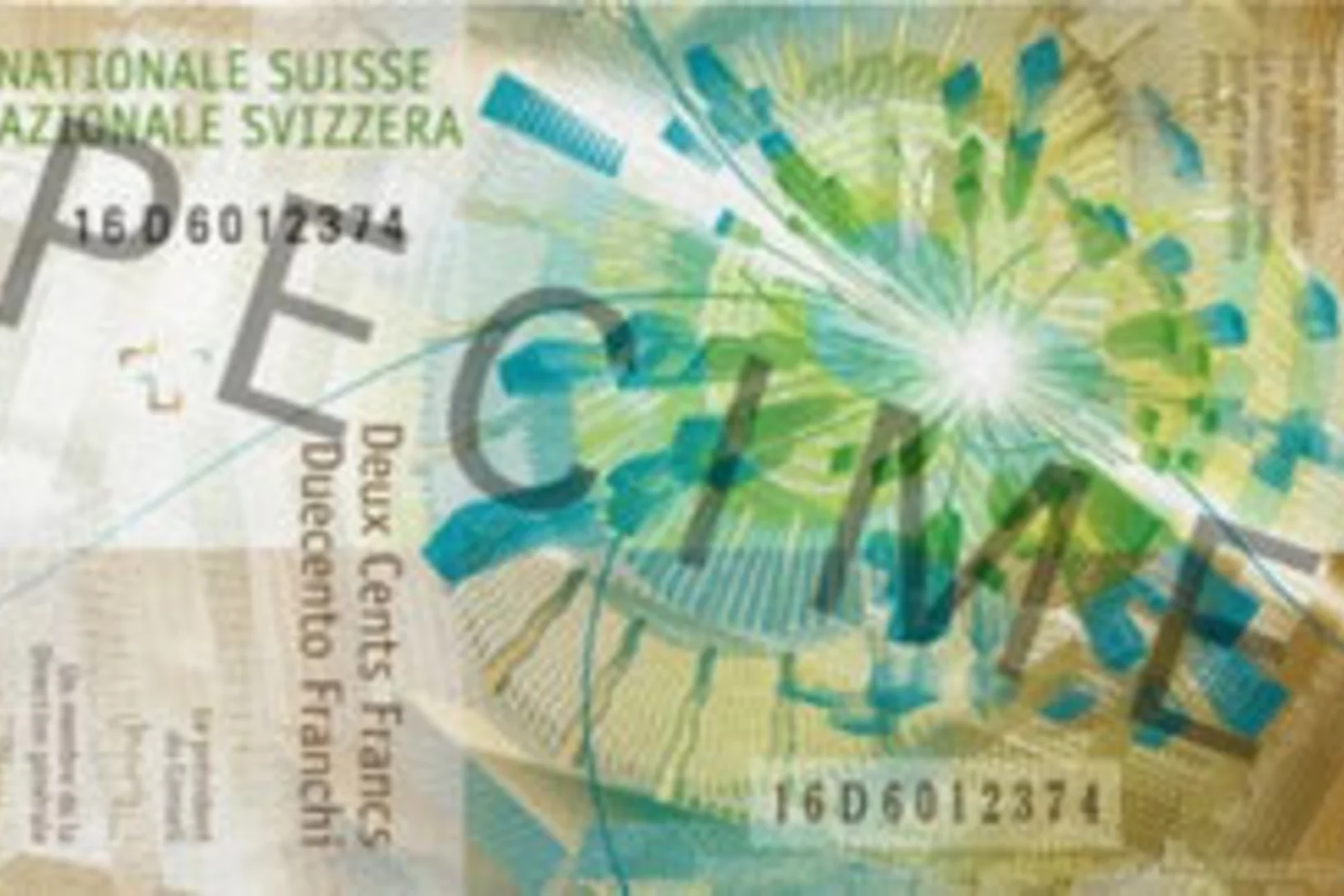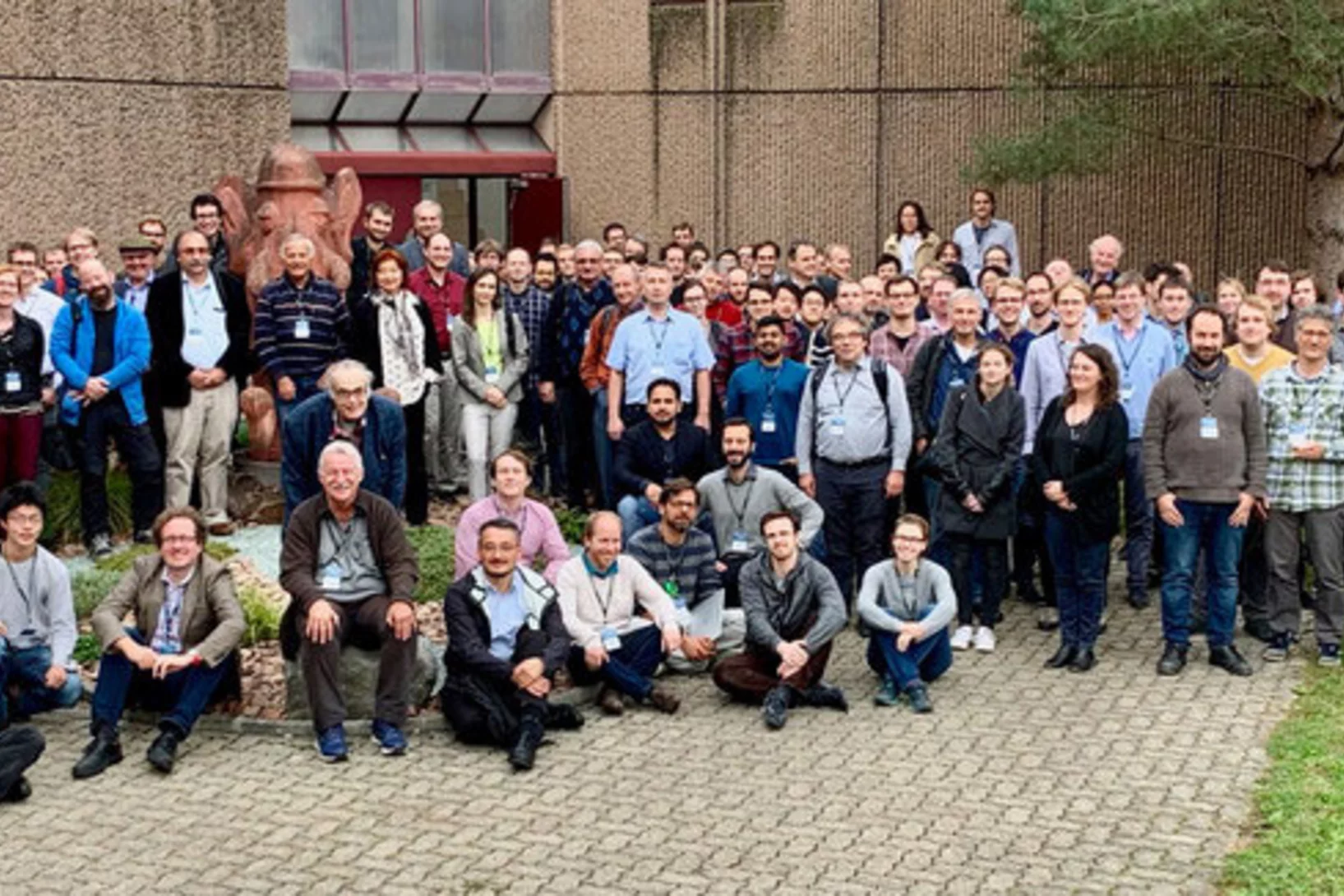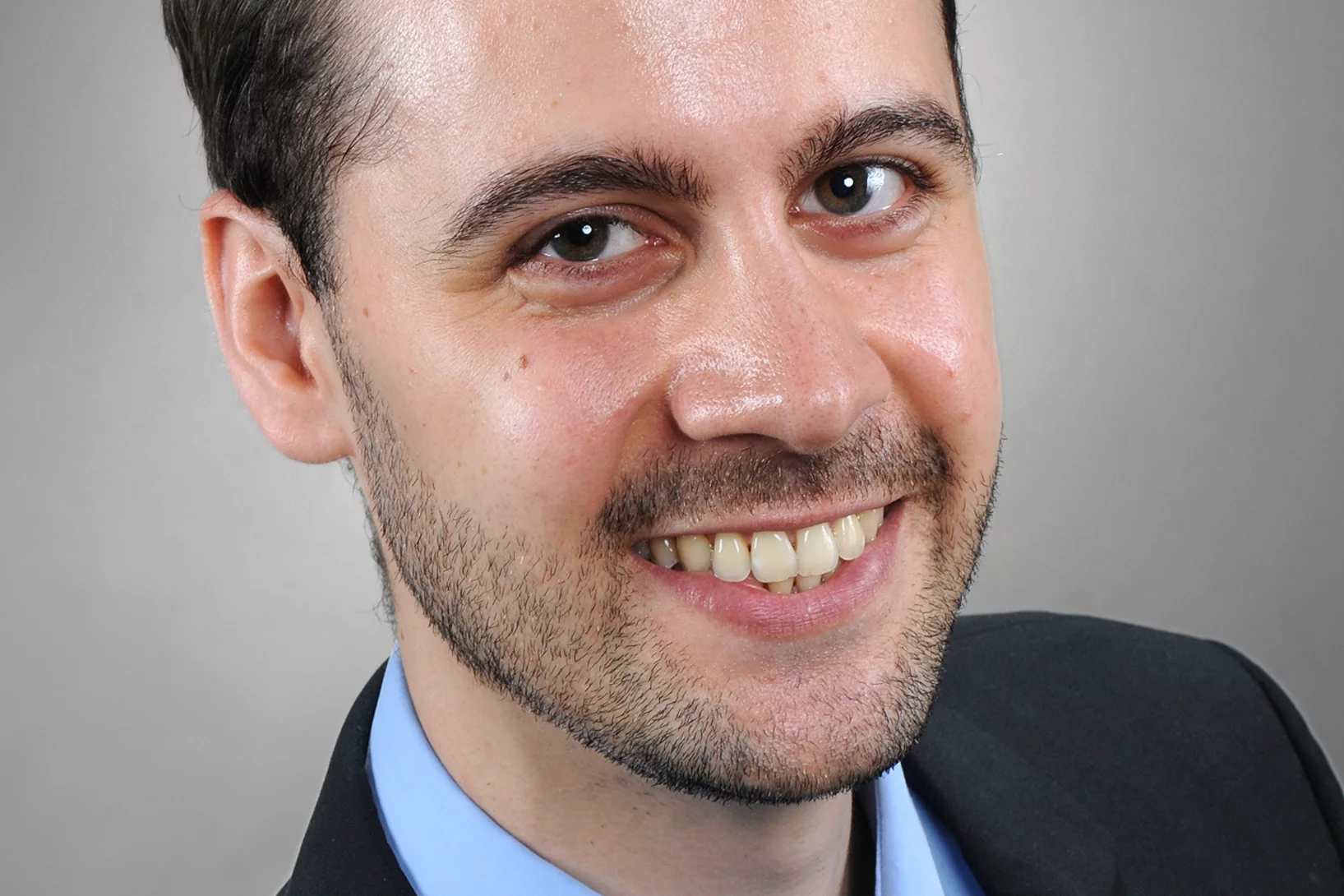Show filters
The Running Bottom Quark Mass and the Higgs Boson
We present a new measurement of the bottom quark mass in the MS scheme at the renormalization scale of the Higgs boson mass from measurements of Higgs boson decay rates at the LHC: mb (mH) = 2.6 +0.36 -0.31 GeV. The measurement has a negligible theory uncertainty and excellent prospects to improve at the HL-LHC and a future Higgs factory.
Antiprotons in superfluid helium: a new way for sensitive measurements of antimatter
Scientists, publishing in Nature, have found that a hybrid antimatter-matter atom behaves in an unexpected way when submerged in superfluid helium.
Two million Swiss francs granted to search for new physics
Philipp Schmidt-Wellenburg will set up a novel experiment at a muon beamline at PSI.
Aldo Antognini Adjunct Professor at ETHZ
Aldo Antognini, currently lecturer and senior scientist at both ETH Zurich and the Laboratory for Particle Physics at NUM/PSI was awarded the title of Adjunct Professor at ETH Zurich.
Higgs-boson pair production at LHC: reliable theoretical uncertainties
Researchers at PSI have refined the theoretical prediction for the pair production of Higgs bosons at the LHC and re-analized the related uncertainties resulting in sizable contributions neglected before. This process will be highly relevant at the high-luminosity run of the LHC to measure the Higgs potential directly.
Update on the Status of HIMB
A workshop to discuss and further develop the science case for the High Intensity Muon Beams (HIMB) has been held.
The link between theory and experiment
Without fundamental constants there is no physics.
Silver medal at the EuroSkills
Silver medal for Mario Liechti at the EuroSkills in Graz, Austria.
CHRISP — All the key results in one place
A specialSciPost volume, entitled “Review of Particle Physics at PSI”, has recently been completed.
The Swiss research infrastructure for particle physics CHRISP
Researchers are looking for deviations in the current standard model of physics and want to find out how our universe is constructed.
Size of helium nucleus measured more precisely than ever before
In experiments at the Paul Scherrer Institute PSI, an international research collaboration has measured the radius of the atomic nucleus of helium five times more precisely than ever before. The researchers are publishing their results today in the journal Nature.
Size of helium nucleus measured more precisely than ever before
In experiments at the Paul Scherrer Institute PSI, an international research collaboration has measured the radius of the atomic nucleus of helium five times more precisely than ever before. The new value can be used to test fundamental physical theories.
Magnetically shielded from the rest of the world
The shielding room in which the n2EDM experiment is expected to clarify whether the neutron has a measurable electric dipole moment or not.
(Photo: Paul Scherrer Institute/Markus Fischer)
Magnetically shielded from the rest of the world
At the Paul Scherrer Institute PSI, researchers together with a company have constructed a room that is one of the best magnetically shielded places on the earth. With its help, they want to solve the last mysteries of matter and answer a fundamental question: Why does matter - and thus why do we - exist at all?
Prestigious IEEE award for Stefan Ritt
Stefan Ritt, leader of the Muon Physics group at the Laboratory for Particle Physics, has received today the prestigious IEEE Emilio Gatti Radiation Instrumentation Technical Achievement Award, for "contributions to the development and democratization of ultra-high-speed digitizers”.
On the winners’ podium at the SwissSkills professional championships
With Mario Liechti (gold) and Melvin Deubelbeiss (bronze) two of our electronics apprentices achieved a place on the winners’ podium at the SwissSkills 2020. The SwissSkills are the Swiss professional championships organized by the leading industry associations. The final competition took place October 27 - 30, 2020 at Schindler Elevators in Ebikon.
Demonstration of Muon-Beam Transverse Phase-Space Compression
We demonstrate efficient transverse compression of a 12.5 MeV=c muon beam stopped in a helium gas target featuring a vertical density gradient and crossed electric and magnetic fields. The muon stop distribution extending vertically over 14 mm was reduced to a 0.25 mm size (rms) within 3.5 μs. The simulation including cross sections ...
Swiss National Science Foundation Ambizione grant for Franziska Hagelstein
Franziska Hagelstein has been awarded a Swiss National Science Foundation Ambizione grant with PSI as host institution. She joined the particle theory group (NUM, Laboratory of Particle Physics LTP) in October 2020. In the near future she will be accompanied by a PhD student.
Global Fit to Modified Neutrino Couplings and the Cabibbo-Angle Anomaly
Recently, discrepancies of up to 4σ between the different determinations of the Cabibbo angle were observed. In this context, we point out that this “Cabibbo-angle anomaly” can be explained by lepton flavor universality violating new physics in the neutrino sector. However, modified neutrino couplings to standard model gauge bosons also affect many other observables sensitive to lepton flavor universality violation, which have to be taken into account in order to assess the viability of this explanation.
Mu3e magnet arrived at PSI
After almost three years of planning, design and construction, the 31-ton, 2.6 Tesla superconducting magnet for the Mu3e experiment arrived today at PSI. The magnet delivery is an important milestone in the Mu3e experiment at the Laboratory of Particle Physics LTP, which will search for New Physics in muon decays over the next years.
In search of new physics
With the high-intensity proton accelerator HIPA, the Paul Scherrer Institute generates elementary particles to clarify how the universe is structured. Using pions, muons, and neutrons, the researchers conduct experiments to test the standard model of particle physics.
Anna Sótér appointed Tenure Track Assistant Professor at ETH Zurich
Anna Sótér, currently Lecturer and SNSF Ambizione Fellow at ETH Zurich, formerly member of the PSI Laboratory for Particle Physics and member of the PSI Fellow program, has been appointed Tenure Track Assistant Professor of Low Energy Particle Physics. Anna Sótér’s research is in the area of exotic atoms, where particle physics, atomic physics and quantum optics meet.
To the sun and beyond
PSI takes part in space research projects. This not only expands knowledge about our astronomical home, but also reinforces Switzerland's reputation as a reliable developer of sophisticated space equipment.
Long-lived pionic helium: Exotic matter experimentally verified for the first time
Exotic atoms, in which electrons are replaced by other particles, allow deep insights into the quantum world. After eight years, an international group of scientists have succeeded in a challenging experiment conducted at PSI’s pion source: they created an artificial atom called “pionic helium”.
Measurement of properties of Bs0 → μ+μ− decays and search for B0 → μ+μ− with the CMS experiment
Results are reported for the B0s → μ+μ− branching fraction and effective lifetime and from a search for the decay B0 → μ+μ−. The analysis uses a data sample of proton-proton collisions accumulated by the CMS experiment in 2011, 2012, and 2016, with center-of-mass energies (integrated luminosities) of 7TeV (5fb−1), 8TeV (20fb−1),and 13TeV (36fb−1).
Tracking down the mystery of matter
At the ultracold neutron source at PSI, researchers have measured a property of the neutron more precisely than ever before: its electric dipole moment. That's because the search is still on for an explanation of why, after the Big Bang, there was more matter than antimatter.
Anna Sótér starts Ambizione fellowship
Anna Sótér has started an Ambizione fellowship at ETH Zurich and PSI. Her project is dedicated to developing a novel source of cold muonium atoms, which will be used for a new interferometry experiment that enables testing the weak equivalence principle by directly probing gravitational interaction of antimatter.
Fascinating colloquium about the 200 Swiss frank banknote
The designers of the new Swiss banknote series together with the scientific advisor Günther Dissertori from ETHZ gave a fascinating PSI-colloquium on the 200 Swiss Frank banknote.
Workshop on the Physics of Fundamental Symmetries and Interactions
The 5th Workshop on the Physics of Fundamental Symmetries and Interactions (PSI2019) took place from 20 to 25 October 2019 at PSI, bringing together 200 scientists from all over the world working on some of today’s most precise particle-physics experiments at the low-energy frontier.
SNSF Ambizione Grant for Max Zoller
Max Zoller has been awarded a Swiss National Science Foundation
Ambizione grant with PSI as host institution.

